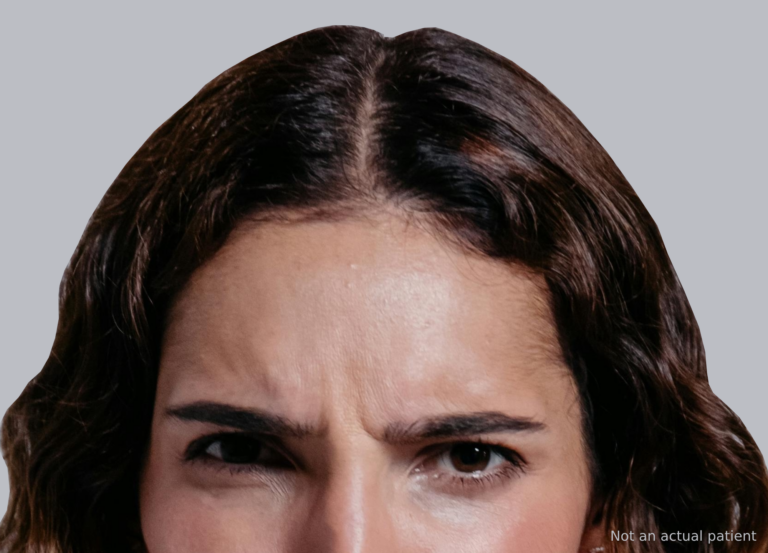Social media is the Wild West: you can get a hot tip and strike gold, or you can get poor intel and get ripped off—or worse, put your life at risk. Both good information and misinformation run rampant online, with experts and regular people alike sharing their opinions and experiences, including on the subject of aesthetic procedures.
The most frequently searched categories are botched results and risks, and while no treatments are without risk, the truth is that most are quite safe—so long as you’re being treated by someone with knowledge and skill. Too many people try to save money by booking procedures through coupon sites or looking for lower-than-average prices; these deals are most frequently offered by providers who are unskilled and/or unqualified. Remember, if something sounds too good to be true, it almost always is. Here, we share some of the treatments that are most commonly decried on social media and the true risks associated with them.
Dermal filler
@slamedical Dermal filler complications are rare but can be fatal if left untreated. This is why attending a medical practitioner who has a vast understanding of anatomy and managing complications! #complication #aesthetics #necrosis #occlusion #dermalfiller #lips ♬ Cornfield Chase – Dorian Marko
One of the scariest risks of dermal filler is vascular occlusion, like what you’ll see here. This risk is very real—it occurs when filler is accidentally injected into a blood vessel. “The filler travels through the vessel until it clogs the vessel at its narrow branches,” explains Dr. Nigar N. Ahmedli, a board-certified otolaryngologist in New York City. This can ultimately cause tissue necrosis and even blindness, depending on where the filler is placed.
You’re at greater risk when treated in “the danger zones,” which Dr. Ben Talei, a board-certified facial plastic surgeon in Beverly Hills, California, notes are around the forehead, the glabella, the sidewalls of the nose, and the areas between the eyes and the nose. Perhaps obviously, the best way to avoid risk is not to be treated in these areas at all, but if you do need treatment here, it needs to be performed by an expert. “Filler injections should be performed only by competent and experienced practitioners who understand anatomy,” says Dr. Jennifer Levine, a board-certified facial plastic surgeon in New York City.
Surprisingly, getting filler under the eyes is not as dangerous, but there is an increased risk of dissatisfaction. “In general, the under-eye area is more unforgiving and difficult to perform in technically,” says Dr. Ahmedli. Adds Dr. Talei, “Even the most perfectly injected under-eye filler may change character and come to the surface 10 years later.”
Ultimately, the most common risks of filler are bumps and nodules and/or filler migration, which are largely due to novice injection techniques, says Dr. Ahmedli, or a provider selecting the wrong product for the treatment area. To correct these issues, you’ll need to dissolve the filler and then reinject it, which is both uncomfortable and pricey. (Remember, only hyaluronic acid [HA] fillers can be dissolved.) The experience of a provider should be what determines whether you book with them, rather than their prices—if you end up getting a poor result from a more affordable practitioner, you’ll end up having to spend more on correction. Keep in mind that not all injectors are the same. “There are weekend courses now that teach providers basic injection techniques,” says Dr. Ahmedli; facial plastic surgeons undergo yearlong training to administer filler using more advanced techniques. “The intricacies of facial anatomy cannot be learned over a matter of days.”
A skilled provider will also tell you if you need a “routine refill,” which not all patients need. “The reps from [filler] companies tell practitioners that these fillers last a definitive amount of time,” explains Dr. Talei. “I advise my patients that HA filler may last six months or 100 years and there is no way to know how it will metabolize on any given person in any given part of their face.” Being treated only as needed will help you avoid looking puffy and overfilled.
Brazilian butt lift
@catchangmd The most dangerous plastic surgery procedure 🫣 #fyp #plasticsurgery #bbl #brazillianbuttlift ♬ original sound – Dr. Catherine Chang
The Brazilian butt lift, performed by grafting a patient’s own fat into their buttocks, has been characterized as the most dangerous plastic surgery procedure available. This is due to a paper published in 2017, which showed evidence that the mortality rate of gluteal fat grafting is higher than that of any other procedure. According to Dr. Nathaniel Villanueva, board-certified plastic surgeon in Beverly Hills, California, the old data portrayed a death rate of 1 in 3,000 patients. “More recent studies have shown the rates of fat embolism in this procedure to be less than 1 in 15,000, which is a much safer rate,” he says, but “some of the older data is still being used, which makes it seem like this is an extremely dangerous procedure.”
Ultimately, the danger comes from injecting the fat into the wrong area of the buttocks. “Fat should be transferred only in the superficial plane between the skin and the muscle or fat,” says Dr. Villanueva. The rate of complication—including the most serious complication, death—increases when fat is injected into or below the muscle. This can cause a fat embolism, meaning injected fat blocks blood flow.
If you’re under the impression that a nonsurgical butt lift using injectable filler is a safer alternative, that’s not necessarily the case. “Filler can be just as dangerous as fat if it’s injected incorrectly,” explains Dr. Villanueva. And unlike fat, filler can migrate, leading to poor aesthetic outcomes; filler also doesn’t last as long as fat. The average cost of a nonsurgical butt lift is about $4,000, while that of a BBL is around $6,700. If you want consistent and lasting results, it’s likely worth splurging on the real procedure.
As with any procedure, BBLs come with serious risk, but risk reduces dramatically when booking with a licensed provider. “The first factor in avoiding risk with a BBL is selecting an experienced, board-certified plastic surgeon who routinely performs BBLs and can have a clear discussion [with the patient] as to what they are doing to make the procedure safe,” says Dr. Villanueva. You’ll also need to follow aftercare instructions, with the most important being to move around after surgery, which will help prevent blood clots.
CoolSculpting
@jpaige0008 #coolsculpting #coolsculptingbeforeandafter #botched #PAH #surgery ♬ original sound – jpaige0008
CoolSculpting is a lipolysis treatment that works by freezing fat cells in a targeted area, causing them to die and be processed by the body, to create a slimming effect. It’s also made headlines recently due to supermodel Linda Evangelista, who experienced paradoxical adipose hyperplasia (PAH) after getting the treatment. (You can see what this looks like in the above clip.) “PAH describes the irony of trying to shrink fat with a device that, in a small percentage of the population, may stimulate fatty regrowth,” says Dr. Talei. Despite the outsized attention it’s received on social media, the side effect is rare. Overall, it’s a relatively low-risk procedure, the most common side effects being sensitivity issues and asymmetry.
Though the risks and side effects are low, they’re still present. “Patients and doctors are sometimes too optimistic in thinking that noninvasive treatments carry lower risk, which isn’t true in most cases,” warns Dr. Talei, who notes that CoolSculpting risk profile is similar to minor lipo, which may better achieve your desired results in one treatment. Most people who express dissatisfaction with CoolSculpting cite the expense and lack of results. This is because the majority of patients require multiple sessions to achieve their desired outcome. “It may work a little, but most practitioners and patients would consider it a disappointment relative to the expectations,” says Dr. Talei. ”It has a place in the market, but I wouldn’t expect miracles.”
Ozempic
@cesar_contrerasjr The negative stories keep coming. I keep warning you…….
♬ original sound – Cesar A Contreras
Drugs like Ozempic (also known by the name of its active molecule, semaglutide) work by making you feel fuller faster and longer after eating; they’ve been quite controversial and subject to many rumors about their safety and efficacy. “GLP-1 receptor agonists like Mounjaro and Ozempic are wonder drugs for the obese patients who need them,” says Dr. Talei. And while there can be some risks to taking this class of medications, most are minor and easily alleviated. “Some of the side effects associated with semaglutide that are most common—nausea, constipation, and diarrhea—are very manageable under close supervision,” says Joe Baczewski, RN, founder of LIVation in Madison, Connecticut. He notes that the latter two concerns are directly related to your body’s hydration levels (lack of sufficient fluids and electrolyte imbalance, respectively).
Another common side effect of semaglutide is a loss of energy, which is often due to a lack of nutrients in a patient’s diet; when you’re in a caloric deficit, your body may not be getting everything it needs to operate at its peak. Possible solutions here include vitamin B12 injections, metabolic oral multivitamins, and carnitine supplements.
This isn’t to say that semaglutide doesn’t come with some more serious risks and side effects. Gastroparesis, or the paralysis of stomach muscles, is a concerning potential risk of GLP-1 agonists that’s been touted in the media quite frequently. But according to Baczewski, it’s not as common as the media would make it out to be. “It’s a serious issue but affects justa small minority of patients,” he says. Regularly checking in with your medical team and being under provider supervision during the course of your semaglutide treatment can greatly reduce or eliminate the risk of gastroparesis and many other side effects. “Patients can have bad outcomes if symptoms are not checked and addressed,” says Baczewski.
Thread lift
@millyrosepowell Replying to @LKH ♬ YEAH RIGHT – Joji
A thread lift is a procedure that uses dissolvable sutures to tighten skin laxity for a minimally invasive facelift or canthoplasty (also known as a fox eye lift). As with any procedure, poor results like the example above are due to poor provider technique. “Each thread is only as good as the person who is placing it,” says Dr. Levine. “Poor thread outcomes are most likely related to superficial placement, causing dimpling or puckering.” You can see an example of poor thread placement in the above video.
Overall, thread lifts are relatively safe when performed by someone skilled with a deep understanding of facial anatomy, especially when used on a younger patient. “Thread lifts are ideal for redistributing the skin for younger patients who do not have a large excess of skin and minimal skin laxity,” explains Dr. Ahmedli. Threads are more easily able to lift elastic, supple tissue and reposition it without pleating. “Threads provide subtle, temporary results but still have a substantial cost,” she says. If you have money to spare and you want to fake the fox eye look for a few years, you may enjoy a thread lift, so long as you see a trained provider.
That said, Dr. Ahmedli doesn’t perform them because she believes the results are unreliable; Dr. Talei also notes that many patients pursue thread lifts with the expectation that they’ll form new collagen for results that last long after the threads have fully dissolved. “Practitioners may say that this restores collagen in the face … this is extremely misleading and inaccurate,” he says. Threads made with PDO (polydioxanone) may build volume by creating collagen scar tissue, but it’s not restoring what you’ve lost. “There are more than 28 types of collagen in the face, and the patterns and placement are really quite different,” says Dr. Talei. It’s worth noting that this scar tissue will ultimately make a future facelift or neck lift more technically challenging for a plastic surgeon—so if you’re hoping to correct significant jowling or contour a fuller lower face, bypass threads and go the surgical route. “If a patient has fullness of the face or neck, it is harder for the thread to ‘lift’ the heavier tissue,” explains Dr. Ahmedli. This increases your risk of skin pucker into too.
Morpheus8
@tezza.barton Anyone know how to fix my face lol 🫶🏼 #morpheus8 #skincare ♬ original sound – Tezza
Morpheus8, one of the buzziest treatments on the market, combines radiofrequency and microneedling to promote collagen production. It’s also been controversial, with some patients saying that it was painful and caused strange texture issues (like in the video above) or volume loss in the face. These issues can occur when using any radiofrequency microneedling device and are typically caused by—you guessed it—an unskilled provider.
“[Side effects like] loss of radiance in the skin, indents in the skin, and fat loss or deflation typically happen when the practitioner treats the wrong skin depths and at too high an intensity or heat level,” explains Dr. Talei. Side effects can also occur in patients with endocrine disorders, like uncontrolled diabetes, says Dr. Kseniya Kobets, a board-certified dermatologist in Elmsford, New York. She also cites poor lifestyle habits like smoking and following a diet heavy in processed foods, which increase inflammation, as potential causes of side effects. “These can play a role in poor outcomes, because [inflammation] can delay proper healing and can potentially result in scarring,” she explains.
In the right hands, Morpheus8 can safely be used on a broad range of patients successfully. “It is a really great device—in my opinion, it’s among the top three devices in the radiofrequency world,” says Dr. Talei. And unlike many energy-based devices, Morpheus8 can be used on patients of color, says Dr. Kobets. “It is one of the safest devices for skin rejuvenation, due to it targeting the water, not pigment, in the skin as well as having insulated needles and measuring impedance and temperature of the skin to minimize scarring.”
While unwanted facial fat loss is terrifying, keep in mind that this aspect of Morpheus8 can be desirable, depending on the treatment area. “We sometimes do want to melt fat in specific locations, like under the chin, and will intentionally treat there to melt the fat and also tighten the skin,” says Dr. Kobets. During a Morpheus8 consultation, be honest with your provider about your medical history, clear about your goals, and above all, thorough in your research so you can get the transformation you’re looking for from the right practitioner.











